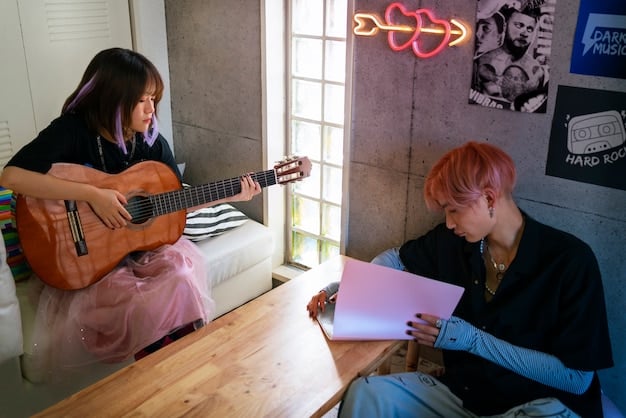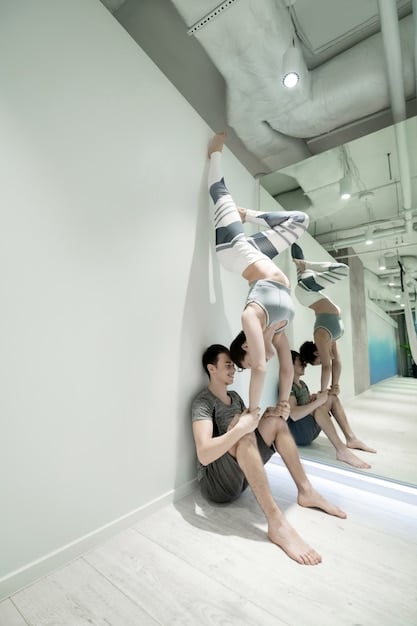Viral K-Pop Covers: Tips for Social Media Challenges

K-Pop cover song challenges are a fantastic route for aspiring artists to showcase their talent, connect with fans, and boost their social media presence by creating engaging and viral content through performance and innovative video production.
Want to take your K-Pop cover game to the next level? K-Pop cover song challenges offer a powerful way to gain visibility and connect with fellow fans. Let’s dive into some essential tips and tricks to make your videos stand out and go viral on social media.
Understanding the K-Pop Cover Song Challenge Phenomenon
K-Pop cover song challenges have surged in popularity, becoming a massive trend on platforms like TikTok, YouTube, and Instagram. These challenges invite individuals and groups to showcase their talent by performing covers of popular K-Pop songs. This phenomenon allows fans to connect with the music on a deeper level and offers a platform for aspiring artists to gain recognition.
Why are K-Pop Cover Challenges So Popular?
Several factors contribute to the widespread popularity of K-Pop cover challenges. First, they provide a creative outlet for fans to express their love for K-Pop. Second, they foster a sense of community as participants share their work and support each other. Finally, the challenges often receive attention from K-Pop idols and agencies, further amplifying their reach.
How to Participate in K-Pop Cover Challenges
Participating in K-Pop cover challenges typically involves selecting a song, recording your cover, and sharing it on social media with a specific hashtag. Many challenges have unique rules or themes, so it’s essential to stay informed and adapt your content accordingly to capture attention.

- Follow the rules: Always adhere to the specific guidelines set by the challenge organizers.
- Use relevant hashtags: Incorporate the official hashtag to increase visibility.
- Engage with the community: Like, comment, and share other participants’ covers to build connections.
Understanding the dynamics of K-Pop cover song challenges is the first step towards creating content that resonates with audiences and achieves virality.
Selecting the Right K-Pop Song for Your Cover
Choosing the perfect K-Pop song for your cover is crucial for maximizing your chances of success in these challenges. Not all songs are created equal, and selecting one that aligns with your strengths and resonates with your target audience can significantly impact your video’s performance.
Consider Your Strengths and Vocal Range
When choosing a song, consider your vocal range and strengths. Select a song that you can sing comfortably and confidently, showcasing your unique vocal abilities. It’s better to choose a song that isn’t as popular but fits your voice perfectly, than to struggle with a chart-topper.
Analyze Trending K-Pop Songs
Keep an eye on trending K-Pop songs and challenges. Songs that are currently popular have a higher chance of attracting viewers. Use platforms like YouTube, TikTok, and Twitter to identify which songs are gaining traction and consider covering those. Don’t forget to check the official accounts of K-Pop groups, as they often highlight fan covers.
Think About the Visual Potential
Visual appeal is critical for social media challenges. Choose a song that has dynamic choreography or interesting visual elements that you can incorporate into your cover. Think about how you can recreate or reinterpret these visuals to make your cover more engaging.
Selecting the right song is not just about picking a popular track; it’s about choosing a song that complements your skills and creative vision, thus increasing your potential to produce outstanding content that goes viral.
Mastering the Performance: Vocals and Choreography
Once you’ve chosen the perfect song, mastering the performance is paramount for creating a cover that stands out. This involves honing your vocal skills and perfecting the choreography to deliver a captivating and authentic rendition.
Vocal Training and Practice Techniques
Dedicate time to vocal training and practice. Work on your breathing, pitch, and pronunciation to ensure your cover sounds polished and professional. Consider recording yourself to identify areas for improvement and refine your technique.
Replicating K-Pop Choreography Accurately
Accuracy is key when replicating K-Pop choreography. Watch the original music video and dance practice videos closely. Break down the steps, practice them slowly, and gradually increase your speed as you become more comfortable. Precise movements contribute significantly to the authenticity of your cover.

- Use mirrors: Practice in front of a mirror to check your form and ensure your movements are aligned with the original choreography.
- Record yourself: Filming yourself allows you to review your performance and identify areas that need improvement.
- Collaborate with others: Join a dance group or practice with friends to get feedback and support.
Mastering both vocals and choreography requires dedication and attention to detail, but the effort pays off in the form of a mesmerizing performance that captures the essence of K-Pop.
High-Quality Video Production: Filming and Editing
In the world of K-Pop cover song challenges, the quality of your video production can make or break your chances of going viral. High-quality filming and editing are essential for capturing and maintaining the attention of your audience.
Essential Equipment for Filming
Investing in essential equipment can significantly improve your video quality. This includes a high-resolution camera (even a smartphone camera can work well), a stable tripod, and appropriate lighting. Good audio equipment is also essential to ensure clear vocals and sound quality.
Effective Editing Techniques for Social Media
Effective editing is critical for creating videos that are engaging and shareable on social media. Use editing software to cut out mistakes, add special effects, and synchronize audio and video. Keep your edits fast-paced and dynamic to maintain viewer interest.\
Adding Visual Effects and Transitions
Visual effects and smooth transitions can enhance the overall appeal of your video. Experiment with overlays, graphics, and creative transitions to add a professional touch.
High-quality video production elevates the appeal of your K-Pop cover, making it stand out amidst the crowded social media landscape. Paying attention to filming and editing is an investment that maximizes audience engagement and viral potential.
Optimizing Your Content for Social Media Platforms
To maximize the visibility and reach of your K-Pop cover song challenges, it’s essential to optimize your content for each social media platform. Tailoring your approach to suit the specific characteristics and audience of each platform can significantly boost your success.
Tailoring Content to TikTok, YouTube, and Instagram
Each platform has its own unique style and user base. On TikTok, focus on shorter, more dynamic videos with trending sounds. On YouTube, create longer, more detailed covers with high production value. On Instagram, use eye-catching visuals and engage with followers through stories and posts.
Using Relevant Hashtags and Keywords
Hashtags and keywords are crucial for increasing your video’s visibility. Research popular K-Pop hashtags and incorporate them into your captions. Use relevant keywords in your video titles and descriptions to improve search engine optimization (SEO).
- Research trending hashtags: Stay updated on the latest K-Pop hashtags by monitoring social media trends.
- Use a mix of broad and specific hashtags: Combine popular, general hashtags with more specific ones related to your cover.
- Include keywords in your titles and descriptions: Optimize your content for search engines by using relevant keywords in your titles and descriptions.
Engaging with Your Audience
Engaging with your audience is essential for building a loyal fan base. Respond to comments, ask for feedback, and participate in discussions. Encourage viewers to share your videos and tag their friends.
Optimizing your content for social media platforms is key to increasing visibility. By tailoring your approach to each platform and actively engaging with your audience, you enhance the potential for your K-Pop covers to go viral, reaching broader audiences and connecting with fans worldwide.
Promoting Your K-Pop Cover and Engaging with the Community
Promoting your K-Pop cover and engaging with the community are vital for maximizing its visibility and impact. Active promotion and genuine interaction with fellow K-Pop enthusiasts can significantly boost your cover’s reach and engagement.
Cross-Promotion Across Platforms
Cross-promotion involves sharing your content across multiple social media platforms to increase its visibility. Promote your YouTube cover on TikTok, your TikTok cover on Instagram, and so on. This strategy can drive traffic from one platform to another, amplifying your reach. Don’t forget to use sharing features and embed options.
Collaborating with Other K-Pop Cover Artists
Collaborating with other K-Pop cover artists can expose your work to a new audience. Joint covers and shared promotion can boost visibility for all participants. Choose collaborators whose styles complement your own and whose audiences overlap with your target demographic.
Participating in K-Pop Online Communities
Active participation in K-Pop online communities allows you to connect with fans and share your work in relevant spaces. Comment on other people’s covers, join discussions, and share your own videos when appropriate. Online communities are great places to network, gain feedback, and build a supportive audience.
Promoting your K-Pop cover and engaging with the community are crucial. Remember genuine interactions, consistent activity, and collaborative efforts often pave the way for achieving viral status and connecting with fellow K-Pop enthusiasts.
| Key Point | Brief Description |
|---|---|
| 🎤 Song Selection | Choose songs matching your vocal range and visual style. |
| 💃 Performance Skills | Master vocal and dance elements for an authentic cover. |
| 🎬 Video Quality | Use quality equipment and editing for engaging content. |
| 📣 Promotion | Promote across platforms; engage with communities. |
Frequently Asked Questions
▼
You can start with just a smartphone with a good camera, a stable tripod, and decent lighting. A separate microphone can improve audio quality.
▼
Accuracy is important but adding your personal flair can make your cover more unique and engaging. Nail the key moves first then improvise!
▼
CapCut and Filmora are user-friendly options with free versions or affordable subscriptions. They offer many features for video and audio editing.
▼
Consistency is advantageous! Aim for regular uploads, like once a week or bi-weekly to keep your audience engaged and to increase video views.
▼
Popular tracks bring more views, while niche tracks attract invested fans. A mix may be best to balance views! Also consider your song preferences.
Conclusion
Creating viral K-Pop cover song challenges requires a mix of talent, technical skill, and strategic promotion. By focusing on high-quality performances, video production, and audience engagement, you can significantly increase your chances of success in the vibrant world of K-Pop.





